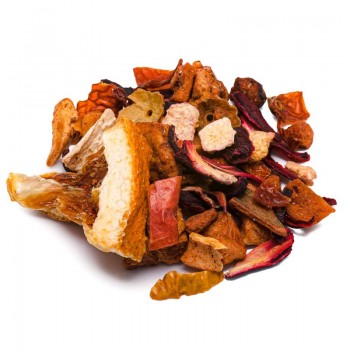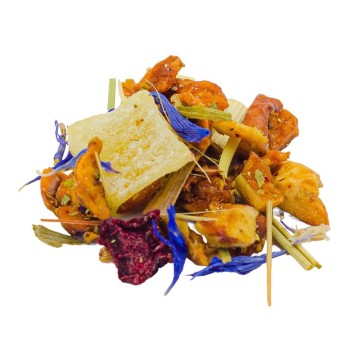One of our most appreciated infusions for its sweet and engaging flavor between spicy aromas and fruity taste, with soft vegetal notes. Some elements such as cinnamon, mistletoe, star anise make it an enchanting hot infusion, perfect in a steaming cup during the holiday season. They enhance the flavor of ingredients such as cranberries and blackberry leaves, which evoke the autumn forest and its fruits. A combination of delicate and lively flavours, slightly sour between blueberry and apple, but always soft on the palate. A mix to be served hot or cold with ice, to create a refreshing and thirst-quenching drink in summer, thanks to the mixture of apples and cranberries. An excellent alternative to fruit juice, with a full and stimulating taste.
Blueberry and eggnog infusion: properties and benefits
By taking this infusion you obtain the virtues of cranberry, enhanced by ingredients and spices that are excellent for well-being. For our natural defense system, apple and blueberry ensure the supply of antioxidants and vitamins, to which are added spices with excellent properties such as cinnamon and star anise. The cranberry-based blend provides a rebalancing break, which can revitalize energy levels thanks to antioxidants. For cardiovascular well-being, the polyphenols and flavonoids of cranberries and blackberry leaves are known, which strengthen the capillaries. Cinnamon also stimulates blood circulation, supported by mistletoe, considered a useful ingredient for vasodilation and the cardiovascular system, and by safflower with its qualities of stimulating circulation.
At a digestive level, the same blueberry compounds that help protect the heart (polyphenols and flavonoids) can also improve the functions of the digestive system, favoring the good bacteria in our stomach and intestine. They counteract irritations and help intestinal transit. From this point of view, apple and cinnamon are also beneficial ingredients for the correct assimilation of food. Blackberry leaves provide tannins and help against diarrhea, with an astringent effect, while cinnamon and star anise promote less flatulence and intestinal gas, digestive spasms, bloating and aerophagia.
The properties of the blueberry and eggnog infusion, thanks to the blackberry leaves and blueberry, also favor the expulsion of excess toxins, by aiding diuresis. Cranberry is known for its role in the well-being of the urinary tract, especially for those with recurrent irritation. The high level of antioxidant anthocyanins present in cranberries helps expel bacteria from the bladder – a gift also present in cinnamon. Additionally, cranberries and apples can make urine more acidic, thus creating an unsuitable environment for the spread of bacteria.
Origins and history of cultivation
The cranberry comes from several types of plants in the Vaccinum genus, but the cranberry is usually the American cranberry (Vaccinium macrocarpon). In the wild it grows in most of the northeastern United States and Canada, displaying round, oblong berries ranging in color from pink to very dark red - sometimes mottled with red and white. Alternatively, the small-fruited or northern cranberry (V. oxycoccos) grows in marshy soils in North America, Asia, and northern and central Europe. The American cranberry grows wild in the mountains of Georgia, Canada, up to Minnesota. It has been cultivated since the beginning of the nineteenth century in various areas of the United States, spreading to Maine, New Jersey, Wisconsin, etc. With the growing trend towards specialized agriculture, cranberry production has become a viable industry with several new plantings in several states.
Fruits and flowers
The cranberry is one of the numerous plants of the Vaccinium genus (Ericaceae family). These are small creeping or climbing plants that produce red fruits, evergreen leaves and small bell-shaped flowers. The round berries ripen in September, from crops that grow best on acidic soil or vegetable mould. Among the most important species is the American cranberry (Vaccinium macrocarpon) followed by the small-fruited cranberry (Vaccinium oxycoccos). Star anise comes from the dried fruits of the Illicium verum tree. The plant is native to Asia (China and Vietnam) and gives a fruit similar to that of anise (Pimpinella anisum), with which it has no relation. The fruit takes its name from the star-shaped arrangement of its carpels (fmodified lines) around the central axis. Individual carpels contain a single seed. The apple plant is the Malus domestica apple tree of the Rosaceae family.
It is a tree native to Asia, now widespread throughout the planet. The fruits differ in size, colour, pulp consistency and other characteristics which make the varieties of apples - used in human nutrition for millennia - numerous. Blackberry leaves derive from the bramble Rubus Fruticosus L. belongs to the Rosaceae family. The perennial plant grows spontaneously in Mediterranean countries, creating the classic blackberry groves. It shows thorns, is climbing and can reach a considerable width (the blackberry stems arch up to about 7 m in length). Mistletoe comes from the Viscum album plant, which belongs to the Santalaceae or Viscaceae family. It is a hemiparasitic evergreen, meaning it lives by exploiting host plant resources. It grows spontaneously in the wooded areas of Europe and America, clinging to host trees such as oak.
Carthamus tinctorius is a herbaceous plant of the Asteraceae family. It is native to arid environments, where it survives thanks to its deep root. Shows a height of 30 to 150 cm, yellow, orange or red flowers. Safflower was used in ancient times as a substitute for saffron, therefore called saffron. It is grown for the vegetable oil extracted from the seeds. Cinnamon comes from the Cinnamomum zeylanicum plant, of the Lauraceae family. Born in the Indian subcontinent on the island of Ceylon (formerly Sri Lanka), today it grows in much of Asia, in Madagascar and on the Seychelles islands. It grows well on moist, well-drained soil, up to about 15 meters tall. Cinnamomum cassia, Vietnamese cinnamon (C. loureiroi), Indonesian cinnamon (C. burmannii) and Malabar cinnamon (C. citriodorum) are also used in cooking.
Nutritional values of blueberry and eggnog infusion
The main active ingredients are the antioxidants flavonoids and anthocyanins; in addition to vitamins A, B and C. Among the minerals we find potassium, calcium, copper, zinc, phosphorus, and other trace elements such as amino acids, organic acids, anethole and tannins. How to use the ingredients in the infusion The infusion is obtained by placing approximately 3-5 grams of the blueberry and eggnog mixture with water at 100 °C in a cup (250 ml). Leave to infuse for 10 to 12 minutes before drinking. Add honey or sugar, if desired.
Blueberry and eggnog infusion: side effects and contraindications
To avoid unwanted effects it is necessary to respect the recommended doses and not exceed the consumption of the infusion for too long periods. Excessive intake can cause nausea, diarrhea, gastrointestinal disorders and headaches. Caution advised for pregnant or breastfeeding women.


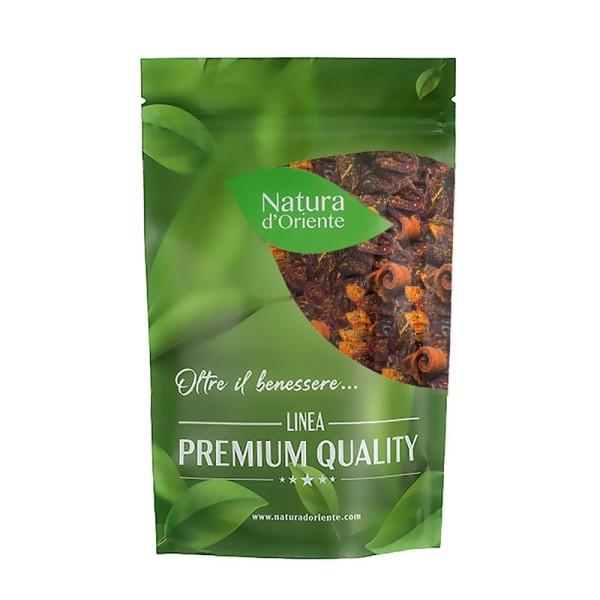








 No reward points for this product.
No reward points for this product.
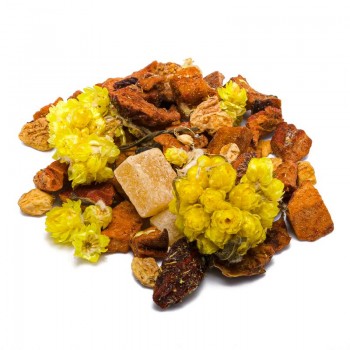
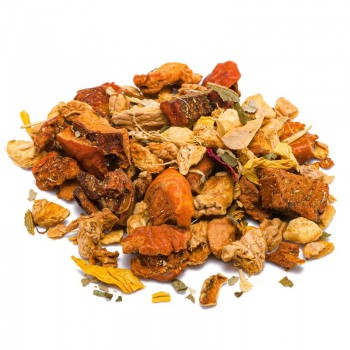
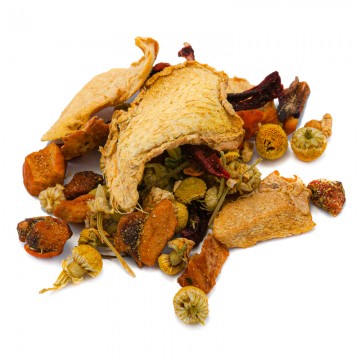




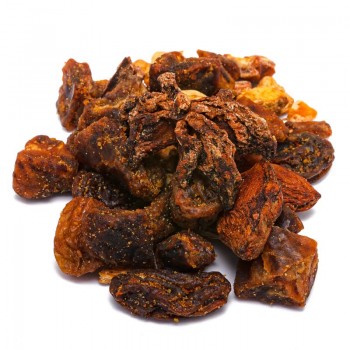
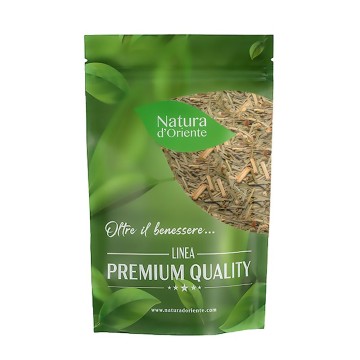
![infuso pesca e vaniglia [Natura d'Oriente]](https://www.naturadoriente.com/3538-home_default/infused-peach-vanilla.jpg)

